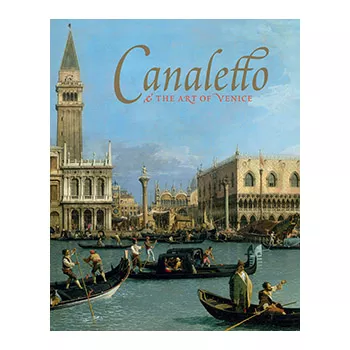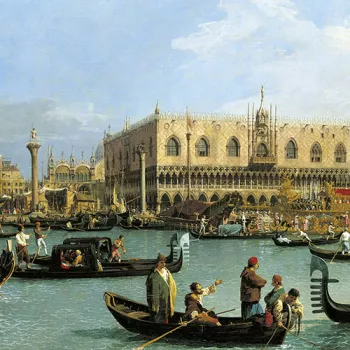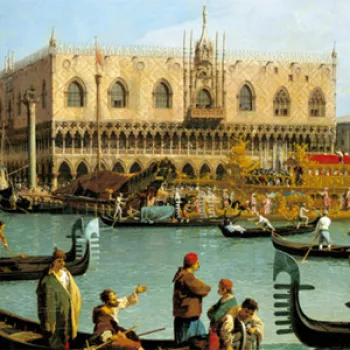The Mouth of the Grand Canal looking West towards the Carità c.1729-30
Oil on canvas | 47.7 x 79.1 cm (support, canvas/panel/stretcher external) | RCIN 400519

Canaletto (Venice 1697-Venice 1768)
The Mouth of the Grand Canal looking West towards the Carita c.1729-30
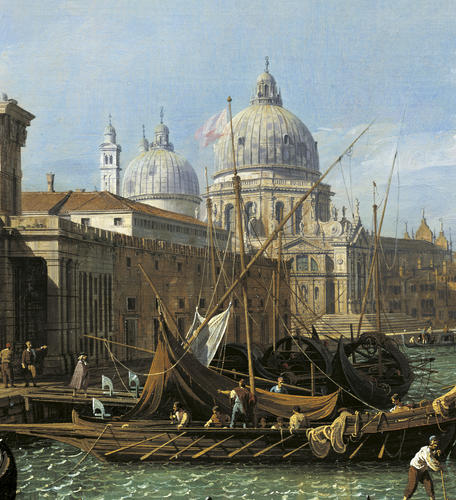
Canaletto (Venice 1697-Venice 1768)
The Mouth of the Grand Canal looking West towards the Carità c.1729-30


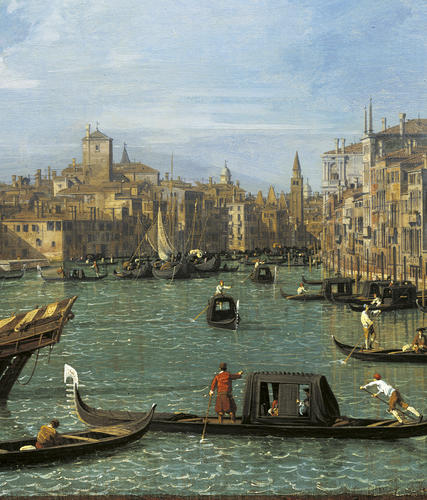
-
This is one of a series of twelve views by Canaletto of the Grand Canal which are all the same format. The pictures form the basis of the fourteen engraved plates in Visentini's Prospectus Magni Canalis Venetiarum (Venice, 1735), thus providing an uncontested date for completion. It is thought that they originated in the years around 1730. The paintings were all acquired by George III with the collection of Consul Smith.
This painting is a pair with The Grand Canal with Santa Maria della Salute looking towards the Riva degli Schiavoni (RCIN 400520), showing the opposite view. On the left is Santa Maria della Salute, with the Dogana di Mare, the customs house in the foreground. Built by Giuseppe Benoni in 1677, the loggia of the Dogana is crowned by Bernardo Falcone's two Atlas figures in bronze supporting a golden globe, on which stands the allegorical figure of Fortune acting as a wind vane. This is an appropriate symbol for the customs house of a state whose wealth depended on maritime trade.
Beyond the Salute are the flank and the cusps of the façade of San Gregorio, followed by the tower of Palazzo Venier delle Torreselle, demolished in the nineteenth century. At the turn of the canal are the belltower and pinnacles (lacking any statues) of Santa Maria della Carità. The right bank is shown as far as Palazzo Corner della Ca' Grande, with Palazzo Badoer in the right foreground; above the rooftops can be seen the old belltower of Santa Maria del Giglio (or Zobenigo), demolished in 1774. The canal is busy with vessels; traders boats line up outside the Dogana, and gondolas make their way across the canal.
Canaletto opens out the view so that more architecture is visible on both sides of the Canal. He painted the same view but without the Dogana, with a narrower Canal and a more crowded effect for Hugh Howard in 1728-9 (Houston, Museum of Fine Arts). Indeed, Canaletto painted this view several times around 1730, and the Royal Collection version may well be the earliest.
In this painting, the development of Canalettto's technique since his early views of the Piazza and Piazzetta of San Marco is evident. The whole view is modelled in wet paint as a single entity: the paint has been manipulated and incised to sculpt the complex detail of the Salute and the rigging, boats and figures in the foreground. Rather than imposing outlines in black for architectural details, each is modelled in wet paint, from dark grey black in the foreground to subtle browns and greys further away while pure black is only used occasionally. The Salute and the buildings beyond are in delicate pastel shades, modulated by veils of atmospheric light.
Catalogue entry adapted from Canaletto in Venice, London, 2005 and Canaletto and the Art of Venice, London, 2017Provenance
Acquired in 1762 by George III from Joseph Smith, British Consul in Venice (Italian List nos 65-76); recorded in the Gallery at Kew in 1805 (no 15-8)
-
Medium and techniques
Oil on canvas
Measurements
47.7 x 79.1 cm (support, canvas/panel/stretcher external)
67.0 x 98.5 x 9.8 cm (frame, external)
Other number(s)
Alternative title(s)
Venice: The Grand Canal from the Salute towards the Carita.




